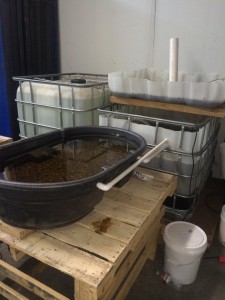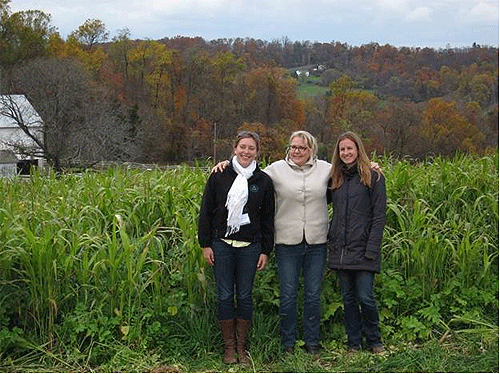Will Aquaponic Gardening Help Solve Food Insecurity in the Future?
 By Emily Nusz
By Emily Nusz
EPA brings in students every summer to work, learn practical environmental skills, and enhance their educational experience through our Pathways Intern Program. The Big Blue Thread has been proud to feature several blogs written by these interns, focusing on what motivates them to work in the environmental sector and what attracted them to EPA. We’ve posted blogs by Andrew Speckin, Sara Lamprise and Kelly Overstreet. Our final blog in this series is the second one by Emily Nusz, who continues to intern with our Environmental Data and Assessment staff.
Water is an essential component of life. Without it, we cannot survive. In my previous blog, I discussed my experience building a well for clean drinking water in Africa. Many developing countries are challenged by the lack of access to clean water. In some cases, people have to walk miles each day just to reach a source, which is why my church’s mission team and I wanted to provide a water well to a village in Nairobi, Kenya.
Water is not the only essential component of life to which some communities across the globe lack access. Finding abundant food sources also may be a problem. I have thought over and over again about how we can solve food insecurity, while also being eco-friendly. During my undergraduate career, I researched and built a system that may have the potential for doing just that. In fact, my former agriculture professor travels to Haiti about once a month to teach this simple gardening technique, which can be used to provide communities with a self-sustaining food supply. This system is unique because it can work anywhere, anytime, through any season.
It’s called aquaponics, a budding technique that allows you to grow your own local, healthy food right in your backyard while using 90 percent less water than traditional gardening. If you are wondering what aquaponics is, you are not alone. The term “aquaponics” is not part of everyday conversation, but soon it may be. I was not introduced to the idea until about a year ago when I began to build a system of my own for academic research.
How It Works
Aquaponic gardening integrates fish and plant growth in a mutual recirculating cycle by combining hydroponics and aquaculture. It is an environmentally friendly way to produce food without harsh chemical fertilizers through a symbiotic relationship. To give you an idea, the fish are able to produce waste that eventually turns into nitrates, which provides essential nutrients for plant growth in a hydroponic environment without any soil. The plants, which are planted in gravel beds, take in the nutrients provided by the fish and help purify the water for the care of the fish. The purified water then flows back to the fish for reuse. Many cultures are able to use this system to not only grow crops, but have a food source of fish as well.
Many types of plants can be grown in the system, such as lettuce, peppers, tomatoes, and cucumbers. Tilapia are the most commonly used fish because they provide extra benefits other fish cannot, such as high levels of ammonia, which is important for maintaining effective system levels.
My Experiment
When I began to build an indoor aquaponic system, my goal was to research if plants and fish could sustain life in an environment lacking nutrients provided by sunlight. The system contained three separate tanks.
Tank 1 was set up as the “breeder tank.” This tank circulated the  nutrients from the fish into the tank containing the plants. Many aquaponic systems do not include a breeder tank, but for my research it was included.
nutrients from the fish into the tank containing the plants. Many aquaponic systems do not include a breeder tank, but for my research it was included.
Tank 2 was set up as the “fish tank.” This tank contained all of the fish (about 50 tilapia). Tank 3 was set up as the “plant tank.” All of the plants were planted in the gravel of this tank to absorb the nutrients provided by the fish. The purified water then flowed from this tank back into tank 2 for reuse.
The water quality of the continuous cycle was observed and recorded over a 10-week period to determine the production of plant growth and water quality in an indoor aquaponic system. Measurements of water quality were collected, including pH, electroconductivity, total dissolved solids, potassium levels, nitrate levels, dissolved oxygen, and temperature.
Although my research did not support sufficient growth of plants in an indoor aquaponic system, it has been found to work indoors using ultraviolet light as a source. Year-round results can also occur by having the system set up in a greenhouse. As long as the system is set up in a controlled environment that mimics nature, fish and plant production will flourish.
The Future
The awareness and potential for aquaponics is beginning to soar. Aquaponics may not be part of everyday conversation yet, but it could make a tremendous change in how we grow our food in the future.
In fact, today EPA tries to incorporate this type of gardening technique to redevelop contaminated Brownfield sites. They work with communities on many of the redevelopment projects to set up urban agriculture practices for food production. There are many benefits to constructing Brownfield sites into agricultural growth areas, especially using the aquaponic system. Urban agriculture has two major benefits for contaminated sites: it binds the contaminants, and it contributes to the growth of local food.
 About the Author: Emily Nusz is a Student Intern at EPA Region 7, who worked full-time this summer and continues to work part-time during the school year. She is a graduate student at the University of Kansas, studying environmental assessment. Emily is SCUBA certified, and one of her life goals is to scuba dive the Great Barrier Reefs off the coast of Australia.
About the Author: Emily Nusz is a Student Intern at EPA Region 7, who worked full-time this summer and continues to work part-time during the school year. She is a graduate student at the University of Kansas, studying environmental assessment. Emily is SCUBA certified, and one of her life goals is to scuba dive the Great Barrier Reefs off the coast of Australia.
Sources:
Emily’s First Blog Entry: https://blog.epa.gov/blog/2015/10/providing-clean-water-to-an-african-village-not-a-simple-turn-of-the-tap/
Brownfields: http://www.epa.gov/brownfields
Land Revitalization/Urban Agriculture Fact Sheet: http://www.epa.gov/sites/production/files/2015-08/documents/fs_urban_agriculture.pdf
USDA Aquaponics Information: https://afsic.nal.usda.gov/aquaculture-and-soilless-farming/aquaponics


